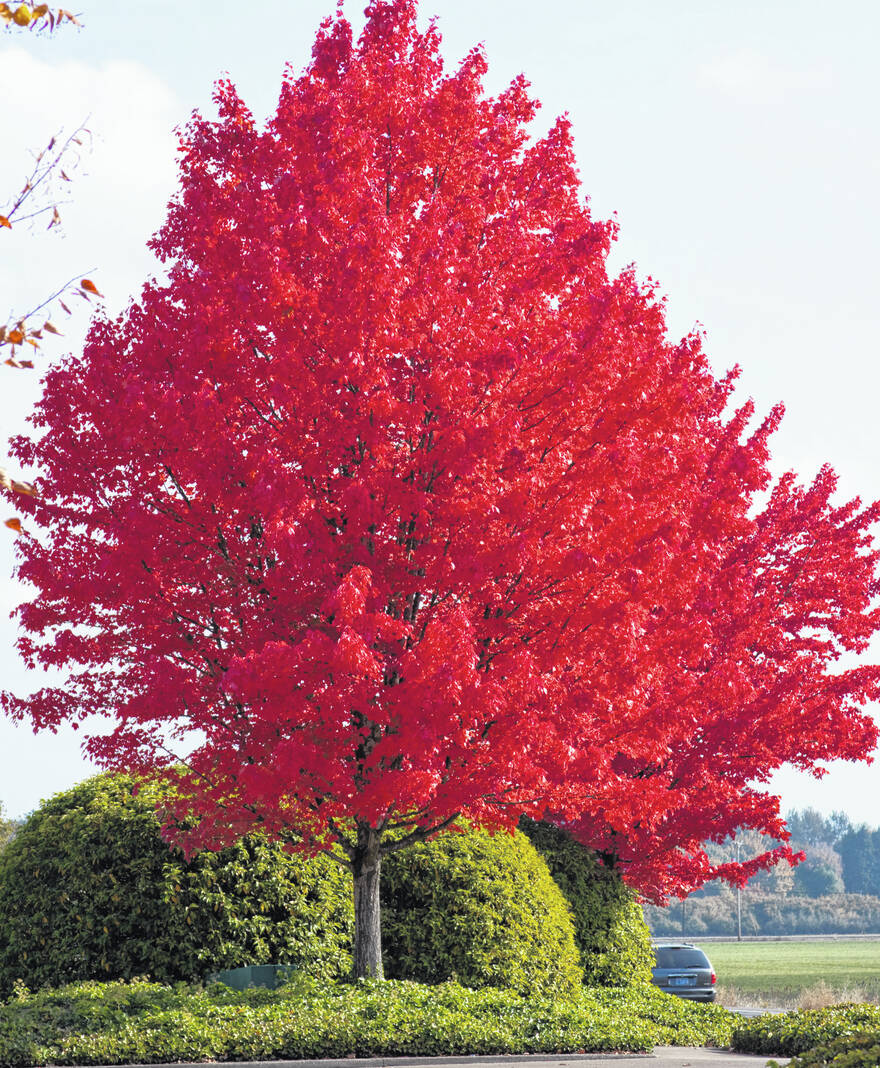

“Autumn Blaze” Freeman maple is one of our favorite fast-growing fall foliage shade trees.
Submitted photo
People often ask me what kind of tree to plant, and then I start asking questions. How much space do you have? What’s the purpose of the tree? Why do you want a tree in that spot? What are the growing conditions?
Why would you plant a particular tree instead of another kind? There’s a place for every tree and a tree for every place; you just have to narrow it down based on what conditions you have and what benefits you want from the tree. Here is our own personal “short list” of tree varieties we find ourselves recommending most often, and planting in landscapes we design.
Bald Cypress: Problem-solver for shade in wet areas or next to ponds. Grows rapidly to a majestic 60 feet, 35 feet wide, can grow in standing water or on dry sites. Fernlike sage-green foliage similar to Dawn redwood, minimal leaf litter.
Freeman maple “Autumn Blaze”: This fall foliage maple is a cross between the fast-growing but problematic silver maple and showy but slow-growing fall foliage maples like “October Glory”. Other Freeman maple hybrids like “Marmo” and “Celebration” also make good shade trees, and are equally pretty in fall. Unlike red maple and sugar maple, Freeman maples grow fast enough to provide shade in your lifetime. 50 feet tall, 35 spread.
Black Gum (also called Tupelo): Dense, shapely shade tree with shiny foliage and great fall color. Very rugged and hardy; perfect medium-sized shade tree for home landscapes, slow growing to fifty feet tall, thirty feet wide.
Pyramidal European Hornbeam: The perfect tree for narrow spaces. Dense, upright growth habit. Small, shiny dark green leaves. Drought tolerant, slow-growing, compact.
Maidenhair tree (Gingko): The oldest known tree still in existence. Very hardy and rugged, drought tolerant once established. Showy lemon yellow fall color. Slow grower to 30 feet wide, 50 feet tall. This tree has survived since pre-history!
Thornless Honeylocust: Ideal tree for filtered shade over paved areas. Fernlike foliage makes pleasant filtered shade. This tree makes minimal leaf litter, doesn’t drop sap or fruit. “Shademaster” has upward-arching limbs for vehicle clearance. “Imperial” and “Skyline”, with umbrella-like horizontal limbs, are our favorites for patio areas. Drought tolerant; tolerates heat off asphalt paving so it’s popular for street tree or parking lot shade. Tough wood resists breakage. Disease free. 35’ spread, 50 ft. tall.
Norway Spruce: The best spruce for southern Ohio. Fast-growing privacy screen or windbreak tree. Well adapted to clay soils. Grows rapidly to 25’ wide and 50’ tall.
London Planetree: Non-fruiting cousin of American Sycamore, a creek-bank native. Tolerates clay soil, extreme wet and dry conditions. Handsome peeling bark, white trunk color. Fast grower to 50-70 feet. Our favorite fast-growing shade tree.
Northern Red Oak: Our favorite tree for lining driveways. Upward-arching limbs for vehicle clearance. Showy fall color. Hardy and trouble-free, grows faster than most oaks, fifty feet tall and wide when mature.
Willow Oak: Fast-growing pyramidal shade tree similar to pin oak in habit but with narrow oval leaves, so leaf litter is minimal. For this reason Willow Oak is a popular park and street tree in the eastern and southeastern US. The Capital Mall in Washington DC is lined with stately Willow Oaks. Grows rapidly to 70 feet tall, 50 feet wide.
There you have it. These are the trees we plant most often, and recommend most often. Chances are one of them will fit the exact situation you have.
Steve Boehme is a landscape designer/installer specializing in landscape “makeovers”. “Let’s Grow” is published weekly; column archives are online at www.goodseedfarm.com. For more information call GoodSeed Farm Landscapes at (937) 587-7021.

